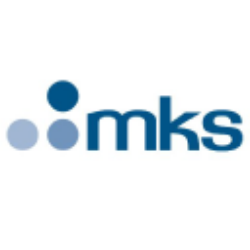MKSI

MKS Instruments, Inc.
MKSI
(1.5)114,30 USD
0.23% ROA
1.34% ROE
800.65x PER
7.204.483.332,00 USD
220.29% DER
1.03% Yield
0.9% NPM
MKS Instruments, Inc. Stock Analysis
MKS Instruments, Inc. Fundamental Analysis
Fundamental analysis in stock investing is like studying the foundation of a house before buying it. It involves looking at a company's financial health, like its earnings, assets, and debts, to determine if it's a good investment based on its fundamental strength and potential for growth.
| # | Analysis | Rating |
|---|---|---|
| 1 |
Revenue Growth
Over the past five years, this company's revenue has consistently increased, demonstrating a robust financial performance that makes it an appealing opportunity. |
|
| 2 |
Dividend
The company's consistent dividend payouts over the past five years exemplify its strong commitment to providing shareholders with reliable returns, making it an attractive investment option. |
|
| 3 |
PBV
The stock's PBV ratio (2.07x) reflects a fair valuation, making it an attractive option for investors seeking balanced opportunities. |
|
| 4 |
Graham Number
The company's Graham number suggests that its stock price is underestimated, implying that it may present a compelling investment opportunity. |
|
| 5 |
ROE
Negative ROE (-49.42%) indicates poor financial performance, raising concerns about profitability and efficiency in utilizing shareholders' equity. |
|
| 6 |
ROA
The stock's ROA (-43.1%) suggests that it's struggling to generate profits from its assets, making it a risky choice for investment. |
|
| 7 |
DER
The stock is burdened with a heavy load of debt (205%), making it financially unstable and potentially risky for investors. |
|
| 8 |
Net Profit Growth
Throughout the last five years, this company's net profit has remained unchanged, indicating a lack of growth and making it a less favorable investment option. |
|
| 9 |
Assets Growth
Company's revenue has remained stagnant over the past three years, indicating a lack of growth and making it a less favorable option. |
|
| 10 |
Dividend Growth
Investors should note the company's stagnant dividend growth over the past three years, indicating limited profitability and potentially diminishing returns. |
|
| 11 |
Buffet Intrinsic Value
Based on Warren Buffett's formula, the company's stock seems overpriced (-213), indicating a potential drawback for investors as its market price exceeds its estimated intrinsic value. |
MKS Instruments, Inc. Technical Analysis
Technical analysis in stock investing is like reading the patterns on a weather map to predict future weather conditions. It involves studying past stock price movements and trading volumes to make predictions about where a stock's price might go next, without necessarily looking at the company's financial health.
| # | Analysis | Recommendation |
|---|---|---|
| 1 | Awesome Oscillator | Hold |
| 2 | MACD | Buy |
| 3 | RSI | Hold |
| 4 | Stoch RSI | Sell |
MKS Instruments, Inc. Price Chart
Financial Statements
Financial statements are like report cards for companies. They show how much money a company makes (income statement), what it owns and owes (balance sheet), and where it spends its money (cash flow statement), helping stock investors understand if a company is healthy and worth investing in.
Income Statements
An income statement for a company is like a scoreboard for its profits and losses. It shows how much money the company made (revenue) and how much it spent to make that money (expenses), helping stock investors see if a company is making a profit or not.
Revenue in stock investing is the total amount of money a company earns from its sales, and it's a key factor that investors consider to assess a company's financial performance and growth potential.
| Year | Revenue | Growth |
|---|---|---|
| 1998 | 139.800.000 | |
| 1999 | 187.100.000 | 25.28% |
| 2000 | 326.955.000 | 42.77% |
| 2001 | 286.808.000 | -14% |
| 2002 | 314.773.000 | 8.88% |
| 2003 | 337.291.000 | 6.68% |
| 2004 | 555.080.000 | 39.24% |
| 2005 | 509.294.000 | -8.99% |
| 2006 | 782.801.000 | 34.94% |
| 2007 | 780.487.000 | -0.3% |
| 2008 | 646.994.000 | -20.63% |
| 2009 | 411.406.000 | -57.26% |
| 2010 | 853.114.000 | 51.78% |
| 2011 | 822.517.000 | -3.72% |
| 2012 | 643.508.000 | -27.82% |
| 2013 | 669.420.000 | 3.87% |
| 2014 | 780.869.000 | 14.27% |
| 2015 | 813.524.000 | 4.01% |
| 2016 | 1.295.342.000 | 37.2% |
| 2017 | 1.915.977.000 | 32.39% |
| 2018 | 2.075.108.000 | 7.67% |
| 2019 | 1.899.800.000 | -9.23% |
| 2020 | 2.330.000.000 | 18.46% |
| 2021 | 2.949.600.000 | 21.01% |
| 2022 | 3.547.000.000 | 16.84% |
| 2023 | 3.728.000.000 | 4.86% |
| 2023 | 3.622.000.000 | -2.93% |
| 2024 | 3.548.000.000 | -2.09% |
Research and Development Expenses are the costs a company incurs to create and improve its products or services, which can be important for investors to evaluate a company's innovation and potential for future growth.
| Year | Research and Development Expenses | Growth |
|---|---|---|
| 1998 | 12.100.000 | |
| 1999 | 13.200.000 | 8.33% |
| 2000 | 23.011.000 | 42.64% |
| 2001 | 37.964.000 | 39.39% |
| 2002 | 45.999.000 | 17.47% |
| 2003 | 47.650.000 | 3.46% |
| 2004 | 56.973.000 | 16.36% |
| 2005 | 55.916.000 | -1.89% |
| 2006 | 69.702.000 | 19.78% |
| 2007 | 72.170.000 | 3.42% |
| 2008 | 78.540.000 | 8.11% |
| 2009 | 53.543.000 | -46.69% |
| 2010 | 62.689.000 | 14.59% |
| 2011 | 61.033.000 | -2.71% |
| 2012 | 60.118.000 | -1.52% |
| 2013 | 63.570.000 | 5.43% |
| 2014 | 62.888.000 | -1.08% |
| 2015 | 68.305.000 | 7.93% |
| 2016 | 110.579.000 | 38.23% |
| 2017 | 132.555.000 | 16.58% |
| 2018 | 135.720.000 | 2.33% |
| 2019 | 164.100.000 | 17.29% |
| 2020 | 173.100.000 | 5.2% |
| 2021 | 200.000.000 | 13.45% |
| 2022 | 241.000.000 | 17.01% |
| 2023 | 284.000.000 | 15.14% |
| 2023 | 288.000.000 | 1.39% |
| 2024 | 264.000.000 | -9.09% |
General and Administrative Expenses are the costs a company incurs to run its day-to-day operations, such as office rent, salaries, and utilities, which investors consider to understand a company's overall efficiency and management effectiveness.
| Year | General and Administrative Expenses | Growth |
|---|---|---|
| 1998 | 0 | |
| 1999 | 39.000.000 | 100% |
| 2000 | 50.888.000 | 23.36% |
| 2001 | 70.185.000 | 27.49% |
| 2002 | 77.830.000 | 9.82% |
| 2003 | 69.891.000 | -11.36% |
| 2004 | 87.284.000 | 19.93% |
| 2005 | 93.021.000 | 6.17% |
| 2006 | 127.703.000 | 27.16% |
| 2007 | 135.249.000 | 5.58% |
| 2008 | 130.800.000 | -3.4% |
| 2009 | 106.330.000 | -23.01% |
| 2010 | 119.841.000 | 11.27% |
| 2011 | 128.015.000 | 6.39% |
| 2012 | 127.185.000 | -0.65% |
| 2013 | 142.014.000 | 10.44% |
| 2014 | 131.828.000 | -7.73% |
| 2015 | 129.087.000 | -2.12% |
| 2016 | 229.171.000 | 43.67% |
| 2017 | 290.548.000 | 21.12% |
| 2018 | 298.118.000 | 2.54% |
| 2019 | 0 | 0% |
| 2020 | 0 | 0% |
| 2021 | 0 | 0% |
| 2022 | 0 | 0% |
| 2023 | 0 | 0% |
| 2023 | 0 | 0% |
| 2024 | 0 | 0% |
EBITDA stands for Earnings Before Interest, Taxes, Depreciation, and Amortization. It is a measure that helps stock investors analyze a company's profitability by looking at its earnings without considering certain expenses. This helps to get a clearer picture of the company's financial performance and its ability to generate cash flow.
| Year | EBITDA | Growth |
|---|---|---|
| 1998 | 15.400.000 | |
| 1999 | 33.900.000 | 54.57% |
| 2000 | 102.369.000 | 66.88% |
| 2001 | -6.887.000 | 1586.41% |
| 2002 | -3.204.000 | -114.95% |
| 2003 | 14.074.000 | 122.77% |
| 2004 | 95.576.000 | 85.27% |
| 2005 | 74.032.000 | -29.1% |
| 2006 | 163.263.000 | 54.65% |
| 2007 | 151.466.000 | -7.79% |
| 2008 | 65.153.000 | -132.48% |
| 2009 | -220.099.000 | 129.6% |
| 2010 | 210.382.000 | 204.62% |
| 2011 | 199.064.000 | -5.69% |
| 2012 | 89.724.000 | -121.86% |
| 2013 | 82.376.000 | -8.92% |
| 2014 | 158.619.000 | 48.07% |
| 2015 | 180.819.000 | 12.28% |
| 2016 | 272.443.000 | 33.63% |
| 2017 | 505.653.000 | 46.12% |
| 2018 | 578.123.000 | 12.54% |
| 2019 | 338.642.000 | -70.72% |
| 2020 | 551.300.000 | 38.57% |
| 2021 | 795.000.000 | 30.65% |
| 2022 | 888.000.000 | 10.47% |
| 2023 | 840.000.000 | -5.71% |
| 2023 | -1.175.000.000 | 171.49% |
| 2024 | 880.000.000 | 233.52% |
Gross profit is the money a company makes from selling its products or services after subtracting the cost of producing or providing them, and it is an important measure for investors to understand a company's profitability.
| Year | Gross Profit | Growth |
|---|---|---|
| 1998 | 62.200.000 | |
| 1999 | 86.100.000 | 27.76% |
| 2000 | 156.912.000 | 45.13% |
| 2001 | 85.583.000 | -83.34% |
| 2002 | 105.795.000 | 19.1% |
| 2003 | 118.109.000 | 10.43% |
| 2004 | 219.371.000 | 46.16% |
| 2005 | 200.434.000 | -9.45% |
| 2006 | 338.122.000 | 40.72% |
| 2007 | 331.487.000 | -2% |
| 2008 | 259.943.000 | -27.52% |
| 2009 | 138.090.000 | -88.24% |
| 2010 | 378.638.000 | 63.53% |
| 2011 | 374.988.000 | -0.97% |
| 2012 | 269.479.000 | -39.15% |
| 2013 | 266.574.000 | -1.09% |
| 2014 | 337.766.000 | 21.08% |
| 2015 | 362.872.000 | 6.92% |
| 2016 | 565.619.000 | 35.85% |
| 2017 | 891.451.000 | 36.55% |
| 2018 | 979.476.000 | 8.99% |
| 2019 | 830.400.000 | -17.95% |
| 2020 | 1.049.500.000 | 20.88% |
| 2021 | 1.380.200.000 | 23.96% |
| 2022 | 1.547.000.000 | 10.78% |
| 2023 | 1.704.000.000 | 9.21% |
| 2023 | 1.642.000.000 | -3.78% |
| 2024 | 1.440.000.000 | -14.03% |
Net income in stock investing is like the money a company actually gets to keep as profit after paying all its bills, and it's an important measure to understand how well a company is doing financially.
| Year | Net Profit | Growth |
|---|---|---|
| 1998 | 5.000.000 | |
| 1999 | 24.000.000 | 79.17% |
| 2000 | 46.234.000 | 48.09% |
| 2001 | -31.043.000 | 248.94% |
| 2002 | -39.537.000 | 21.48% |
| 2003 | -16.385.000 | -141.3% |
| 2004 | 69.839.000 | 123.46% |
| 2005 | 34.565.000 | -102.05% |
| 2006 | 94.235.000 | 63.32% |
| 2007 | 86.360.000 | -9.12% |
| 2008 | 30.117.000 | -186.75% |
| 2009 | -212.659.000 | 114.16% |
| 2010 | 142.587.000 | 249.14% |
| 2011 | 129.731.000 | -9.91% |
| 2012 | 48.029.000 | -170.11% |
| 2013 | 35.776.000 | -34.25% |
| 2014 | 115.778.000 | 69.1% |
| 2015 | 122.297.000 | 5.33% |
| 2016 | 104.809.000 | -16.69% |
| 2017 | 339.132.000 | 69.09% |
| 2018 | 392.896.000 | 13.68% |
| 2019 | 140.400.000 | -179.84% |
| 2020 | 350.000.000 | 59.89% |
| 2021 | 551.000.000 | 36.48% |
| 2022 | 333.000.000 | -65.47% |
| 2023 | 156.000.000 | -113.46% |
| 2023 | -1.841.000.000 | 108.47% |
| 2024 | 92.000.000 | 2101.09% |
EPS, or earnings per share, is a measure that shows how much profit a company has earned for each outstanding share of its stock, and it is important for stock investors as it helps understand the profitability of a company and compare it with other companies in the market.
| Year | Earning per Share (EPS) | Growth |
|---|---|---|
| 1998 | 0 | |
| 1999 | 1 | 100% |
| 2000 | 1 | 0% |
| 2001 | -1 | 0% |
| 2002 | -1 | 0% |
| 2003 | 0 | 0% |
| 2004 | 1 | 100% |
| 2005 | 1 | 0% |
| 2006 | 2 | 100% |
| 2007 | 2 | 0% |
| 2008 | 1 | 0% |
| 2009 | -4 | 100% |
| 2010 | 3 | 300% |
| 2011 | 2 | 0% |
| 2012 | 1 | 0% |
| 2013 | 1 | 0% |
| 2014 | 2 | 100% |
| 2015 | 2 | 0% |
| 2016 | 2 | -100% |
| 2017 | 6 | 83.33% |
| 2018 | 7 | 14.29% |
| 2019 | 3 | -250% |
| 2020 | 6 | 66.67% |
| 2021 | 10 | 33.33% |
| 2022 | 6 | -80% |
| 2023 | 2 | -150% |
| 2023 | -28 | 107.41% |
| 2024 | 1 | 2800% |
Cashflow Statements
Cashflow statements show the movement of money in and out of a company, helping stock investors understand how much money a company makes and spends. By examining cashflow statements, investors can assess if a company is generating enough cash to pay its bills, invest in growth, and provide returns to stockholders.
Free cash flow is the leftover cash that a company generates after covering its operating expenses and capital expenditures, which is important for stock investors as it shows how much money a company has available to invest in growth, pay dividends, or reduce debt.
| Year | Free Cashflow | Growth |
|---|---|---|
| 1998 | 19.900.000 | |
| 1999 | 11.600.000 | -71.55% |
| 2000 | 23.038.000 | 49.65% |
| 2001 | 5.470.000 | -321.17% |
| 2002 | 5.901.000 | 7.3% |
| 2003 | -6.533.000 | 190.33% |
| 2004 | 48.129.000 | 113.57% |
| 2005 | 53.879.000 | 10.67% |
| 2006 | 67.521.000 | 20.2% |
| 2007 | 104.029.000 | 35.09% |
| 2008 | 76.320.000 | -36.31% |
| 2009 | 3.189.000 | -2293.23% |
| 2010 | 147.651.000 | 97.84% |
| 2011 | 140.469.000 | -5.11% |
| 2012 | 119.462.000 | -17.58% |
| 2013 | 63.677.000 | -87.61% |
| 2014 | 88.731.000 | 28.24% |
| 2015 | 125.881.000 | 29.51% |
| 2016 | 160.975.000 | 21.8% |
| 2017 | 323.935.000 | 50.31% |
| 2018 | 350.840.000 | 7.67% |
| 2019 | 180.600.000 | -94.26% |
| 2020 | 428.300.000 | 57.83% |
| 2021 | 552.800.000 | 22.52% |
| 2022 | 365.000.000 | -51.45% |
| 2023 | 223.000.000 | -63.68% |
| 2023 | 142.000.000 | -57.04% |
| 2024 | 64.000.000 | -121.88% |
Operating cash flow represents the cash generated or consumed by a company's day-to-day operations, excluding external investing or financing activities, and is crucial for stock investors as it shows how much cash a company is generating from its core business operations.
| Year | Operating Cashflow | Growth |
|---|---|---|
| 1998 | 23.000.000 | |
| 1999 | 17.100.000 | -34.5% |
| 2000 | 34.034.000 | 49.76% |
| 2001 | 20.108.000 | -69.26% |
| 2002 | 13.849.000 | -45.19% |
| 2003 | -185.000 | 7585.95% |
| 2004 | 66.399.000 | 100.28% |
| 2005 | 64.160.000 | -3.49% |
| 2006 | 78.211.000 | 17.97% |
| 2007 | 119.119.000 | 34.34% |
| 2008 | 89.777.000 | -32.68% |
| 2009 | 7.368.000 | -1118.47% |
| 2010 | 163.470.000 | 95.49% |
| 2011 | 156.036.000 | -4.76% |
| 2012 | 137.167.000 | -13.76% |
| 2013 | 76.087.000 | -80.28% |
| 2014 | 101.914.000 | 25.34% |
| 2015 | 138.295.000 | 26.31% |
| 2016 | 180.098.000 | 23.21% |
| 2017 | 355.222.000 | 49.3% |
| 2018 | 413.781.000 | 14.15% |
| 2019 | 244.500.000 | -69.24% |
| 2020 | 513.200.000 | 52.36% |
| 2021 | 639.500.000 | 19.75% |
| 2022 | 529.000.000 | -20.89% |
| 2023 | 310.000.000 | -70.65% |
| 2023 | 160.000.000 | -93.75% |
| 2024 | 91.000.000 | -75.82% |
Capex, short for capital expenditures, refers to the money a company spends on acquiring or upgrading tangible assets like buildings, equipment, or technology, which is important for stock investors as it indicates how much a company is investing in its infrastructure to support future growth and profitability.
| Year | Capital Expenditure | Growth |
|---|---|---|
| 1998 | 3.100.000 | |
| 1999 | 5.500.000 | 43.64% |
| 2000 | 10.996.000 | 49.98% |
| 2001 | 14.638.000 | 24.88% |
| 2002 | 7.948.000 | -84.17% |
| 2003 | 6.348.000 | -25.2% |
| 2004 | 18.270.000 | 65.25% |
| 2005 | 10.281.000 | -77.71% |
| 2006 | 10.690.000 | 3.83% |
| 2007 | 15.090.000 | 29.16% |
| 2008 | 13.457.000 | -12.13% |
| 2009 | 4.179.000 | -222.01% |
| 2010 | 15.819.000 | 73.58% |
| 2011 | 15.567.000 | -1.62% |
| 2012 | 17.705.000 | 12.08% |
| 2013 | 12.410.000 | -42.67% |
| 2014 | 13.183.000 | 5.86% |
| 2015 | 12.414.000 | -6.19% |
| 2016 | 19.123.000 | 35.08% |
| 2017 | 31.287.000 | 38.88% |
| 2018 | 62.941.000 | 50.29% |
| 2019 | 63.900.000 | 1.5% |
| 2020 | 84.900.000 | 24.73% |
| 2021 | 86.700.000 | 2.08% |
| 2022 | 164.000.000 | 47.13% |
| 2023 | 87.000.000 | -88.51% |
| 2023 | 18.000.000 | -383.33% |
| 2024 | 27.000.000 | 33.33% |
Balance Sheet
Balance sheets provide a snapshot of a company's financial health and its assets (such as cash, inventory, and property) and liabilities (like debts and obligations) at a specific point in time. For stock investors, balance sheets help assess the company's overall worth and evaluate its ability to meet financial obligations and support future growth.
Equity refers to the ownership interest or stake that shareholders have in a company, representing their claim on its assets and earnings after all debts and liabilities are paid.
| Year | Equity | Growth |
|---|---|---|
| 1998 | 18.900.000 | |
| 1999 | 119.200.000 | 84.14% |
| 2000 | 198.935.000 | 40.08% |
| 2001 | 352.871.000 | 43.62% |
| 2002 | 610.690.000 | 42.22% |
| 2003 | 608.310.000 | -0.39% |
| 2004 | 726.634.000 | 16.28% |
| 2005 | 762.843.000 | 4.75% |
| 2006 | 901.219.000 | 15.35% |
| 2007 | 954.009.000 | 5.53% |
| 2008 | 886.698.000 | -7.59% |
| 2009 | 684.933.000 | -29.46% |
| 2010 | 847.039.000 | 19.14% |
| 2011 | 990.012.000 | 14.44% |
| 2012 | 1.012.156.000 | 2.19% |
| 2013 | 1.021.523.000 | 0.92% |
| 2014 | 1.081.822.000 | 5.57% |
| 2015 | 1.160.881.000 | 6.81% |
| 2016 | 1.241.792.000 | 6.52% |
| 2017 | 1.588.907.000 | 21.85% |
| 2018 | 1.873.187.000 | 15.18% |
| 2019 | 2.023.300.000 | 7.42% |
| 2020 | 2.360.900.000 | 14.3% |
| 2021 | 2.886.600.000 | 18.21% |
| 2022 | 4.483.000.000 | 35.61% |
| 2023 | 2.476.000.000 | -81.06% |
| 2023 | 2.472.000.000 | -0.16% |
| 2024 | 2.233.000.000 | -10.7% |
Assets represent the valuable resources that a company owns, such as cash, inventory, property, and equipment, and understanding a company's assets helps investors assess its value and potential for generating future profits.
| Year | Assets | Growth |
|---|---|---|
| 1998 | 96.200.000 | |
| 1999 | 174.600.000 | 44.9% |
| 2000 | 266.383.000 | 34.46% |
| 2001 | 411.189.000 | 35.22% |
| 2002 | 685.623.000 | 40.03% |
| 2003 | 692.862.000 | 1.04% |
| 2004 | 828.677.000 | 16.39% |
| 2005 | 863.740.000 | 4.06% |
| 2006 | 1.043.720.000 | 17.24% |
| 2007 | 1.076.260.000 | 3.02% |
| 2008 | 984.939.000 | -9.27% |
| 2009 | 774.069.000 | -27.24% |
| 2010 | 982.413.000 | 21.21% |
| 2011 | 1.118.654.000 | 12.18% |
| 2012 | 1.134.842.000 | 1.43% |
| 2013 | 1.213.018.000 | 6.44% |
| 2014 | 1.223.655.000 | 0.87% |
| 2015 | 1.273.347.000 | 3.9% |
| 2016 | 2.212.242.000 | 42.44% |
| 2017 | 2.414.018.000 | 8.36% |
| 2018 | 2.614.246.000 | 7.66% |
| 2019 | 3.416.300.000 | 23.48% |
| 2020 | 3.898.500.000 | 12.37% |
| 2021 | 4.540.300.000 | 14.14% |
| 2022 | 11.495.000.000 | 60.5% |
| 2023 | 9.140.000.000 | -25.77% |
| 2023 | 9.118.000.000 | -0.24% |
| 2024 | 8.863.000.000 | -2.88% |
Liabilities refer to the financial obligations or debts that a company owes to creditors or external parties, and understanding a company's liabilities is important for investors as it helps assess the company's financial risk and ability to meet its obligations.
| Year | Liabilities | Growth |
|---|---|---|
| 1998 | 77.300.000 | |
| 1999 | 55.400.000 | -39.53% |
| 2000 | 67.448.000 | 17.86% |
| 2001 | 58.318.000 | -15.66% |
| 2002 | 74.933.000 | 22.17% |
| 2003 | 84.552.000 | 11.38% |
| 2004 | 102.043.000 | 17.14% |
| 2005 | 100.897.000 | -1.14% |
| 2006 | 142.501.000 | 29.2% |
| 2007 | 122.251.000 | -16.56% |
| 2008 | 98.241.000 | -24.44% |
| 2009 | 89.136.000 | -10.21% |
| 2010 | 135.374.000 | 34.16% |
| 2011 | 128.642.000 | -5.23% |
| 2012 | 122.686.000 | -4.85% |
| 2013 | 191.495.000 | 35.93% |
| 2014 | 141.833.000 | -35.01% |
| 2015 | 112.466.000 | -26.11% |
| 2016 | 970.450.000 | 88.41% |
| 2017 | 825.111.000 | -17.61% |
| 2018 | 741.059.000 | -11.34% |
| 2019 | 1.393.000.000 | 46.8% |
| 2020 | 1.537.600.000 | 9.4% |
| 2021 | 1.653.700.000 | 7.02% |
| 2022 | 7.012.000.000 | 76.42% |
| 2023 | 6.664.000.000 | -5.22% |
| 2023 | 6.646.000.000 | -0.27% |
| 2024 | 6.630.000.000 | -0.24% |
MKS Instruments, Inc. Financial Ratio (TTM)
Valuation Metrics
- Revenue per Share
- 53.19
- Net Income per Share
- 0.13
- Price to Earning Ratio
- 800.65x
- Price To Sales Ratio
- 2.01x
- POCF Ratio
- 14.77
- PFCF Ratio
- 18.43
- Price to Book Ratio
- 3.23
- EV to Sales
- 3.21
- EV Over EBITDA
- 13.74
- EV to Operating CashFlow
- 23.52
- EV to FreeCashFlow
- 29.35
- Earnings Yield
- 0
- FreeCashFlow Yield
- 0.05
- Market Cap
- 7,20 Bil.
- Enterprise Value
- 11,48 Bil.
- Graham Number
- 9.99
- Graham NetNet
- -72
Income Statement Metrics
- Net Income per Share
- 0.13
- Income Quality
- 54.22
- ROE
- 0
- Return On Assets
- 0
- Return On Capital Employed
- 0.06
- Net Income per EBT
- 1.45
- EBT Per Ebit
- 0.05
- Ebit per Revenue
- 0.14
- Effective Tax Rate
- -0.45
Margins
- Sales, General, & Administrative to Revenue
- 0
- Research & Developement to Revenue
- 0.08
- Stock Based Compensation to Revenue
- 0.01
- Gross Profit Margin
- 0.42
- Operating Profit Margin
- 0.14
- Pretax Profit Margin
- 0.01
- Net Profit Margin
- 0.01
Dividends
- Dividend Yield
- 0.01
- Dividend Yield %
- 1.03
- Payout Ratio
- 6.67
- Dividend Per Share
- 1.1
Operating Metrics
- Operating Cashflow per Share
- 7.25
- Free CashFlow per Share
- 5.81
- Capex to Operating CashFlow
- 0.2
- Capex to Revenue
- 0.03
- Capex to Depreciation
- 0.27
- Return on Invested Capital
- -0.04
- Return on Tangible Assets
- 0
- Days Sales Outstanding
- 63.11
- Days Payables Outstanding
- 50.58
- Days of Inventory on Hand
- 163.03
- Receivables Turnover
- 5.78
- Payables Turnover
- 7.22
- Inventory Turnover
- 2.24
- Capex per Share
- 1.44
Balance Sheet
- Cash per Share
- 12,64
- Book Value per Share
- 33,18
- Tangible Book Value per Share
- -39.82
- Shareholders Equity per Share
- 33.18
- Interest Debt per Share
- 78.35
- Debt to Equity
- 2.2
- Debt to Assets
- 0.56
- Net Debt to EBITDA
- 5.11
- Current Ratio
- 3.58
- Tangible Asset Value
- -2,68 Bil.
- Net Current Asset Value
- -3,98 Bil.
- Invested Capital
- 7809000000
- Working Capital
- 1,91 Bil.
- Intangibles to Total Assets
- 0.55
- Average Receivables
- 0,61 Bil.
- Average Payables
- 0,29 Bil.
- Average Inventory
- 954500000
- Debt to Market Cap
- 0.68
Dividends
Dividends in stock investing are like rewards that companies give to their shareholders. They are a portion of the company's profits distributed to investors, typically in the form of cash payments, as a way for them to share in the company's success.
| Year | Dividends | Growth |
|---|---|---|
| 2011 | 1 | |
| 2012 | 1 | 0% |
| 2013 | 1 | 0% |
| 2014 | 1 | 0% |
| 2015 | 1 | 0% |
| 2016 | 1 | 0% |
| 2017 | 1 | 0% |
| 2018 | 1 | 0% |
| 2019 | 1 | 0% |
| 2020 | 1 | 0% |
| 2021 | 1 | 0% |
| 2022 | 1 | 0% |
| 2023 | 1 | 0% |
| 2024 | 1 | 0% |
MKS Instruments, Inc. Profile
About MKS Instruments, Inc.
MKS Instruments, Inc. provides instruments, systems, subsystems, and process control solutions that measure, monitor, deliver, analyze, power, and control critical parameters of manufacturing processes worldwide. Its Vacuum & Analysis segment offers pressure and vacuum control solutions, including direct and indirect pressure measurement; materials delivery solutions comprising flow and valve technologies, as well as integrated pressure measurement and control subsystems, which provide customers with precise control capabilities; power solutions products, such as microwave, power delivery systems, radio frequency matching networks, and metrology products used in providing energy to etching, stripping, and deposition processes; and plasma and reactive gas products. Its Light & Motion segment offers laser products, such as continuous wave and pulsed nanosecond, diode and diode-pumped solid-state, and fiber laser technologies; and photonics products comprising motion control, optical tables and vibration isolation systems, photonic instruments, optics and optical assemblies, opto-mechanical components, temperature sensing products for wafer fabrication systems, and laser and LED measurement products, including laser power and energy meters, laser beam profilers, and optical and photonic subsystems. Its Equipment & Solutions segment provides laser-based systems for printed circuit board (PCB) manufacturing, including flexible interconnect PCB processing systems and high-density interconnect solutions for rigid PCB manufacturing and substrate processing, and multi-layer ceramic capacitor test systems. It serves semiconductor, industrial technologies, life and health sciences, research, and defense markets. It sells its products and services through its direct sales organization, independent distributors, and sales representatives, as well as through its websites and product catalogs. The company was incorporated in 1961 and is headquartered in Andover, Massachusetts.
- CEO
- Dr. John T. C. Lee Ph.D.
- Employee
- 10.000
- Address
-
2 Tech Drive
Andover, 01810
MKS Instruments, Inc. Executives & BODs
| # | Name | Age |
|---|---|---|
| 1 |
Ms. Madhuri A. Andrews Executive Vice President & Chief Information Officer |
70 |
| 2 |
Mr. Ramakumar Mayampurath EVice President, Chief Financial Officer & Treasurer |
70 |
| 3 |
Dr. Paretosh Misra C.F.A., Ph.D. Vice President of Investor Relations |
70 |
| 4 |
Sally Ann Bouley Executive Vice President & Chief Human Resources Officer |
70 |
| 5 |
Mr. Eric Robert Taranto Executive Vice President & GM of Vacuum Solutions Division |
70 |
| 6 |
Mr. David Philip Henry Executive Vice President of Operations & Corporate Marketing |
70 |
| 7 |
Dr. John T. C. Lee Ph.D. President, Chief Executive Officer & Director |
70 |
| 8 |
Ms. Kathleen F. Burke Esq. Executive Vice President, General Counsel & Secretary |
70 |
| 9 |
Mr. James Alan Schreiner Executive Vice President & Chief Operating Officer of Materials Solutions Division |
70 |
| 10 |
Ms. Michelle M. McCarthy Vice President & Chief Accounting Officer |
70 |









